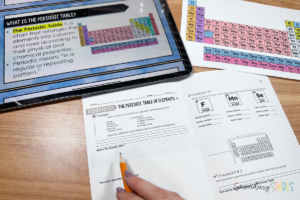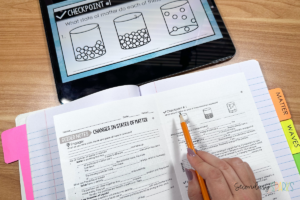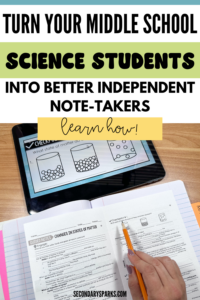Note-taking is a learned skill, and one that students will use in high school, college, and beyond! If we don’t teach students how to take notes or practice note-taking together, expect a hot mess of notes from students. These note-taking strategies for middle school science will help you make the most of note-taking in your classroom and allow you to help students create usable notes they can use to study and recall information.
Note-Taking Strategies for Middle Schoolers
#1 Provide structured or scaffolded notes to start. This is a great starting point when students begin to practice note-taking because it models for students what notes should look like. Eventually, they won’t need as much structure.

#2 Model effective note-taking. Show them how you would take notes during a lesson by thinking out loud. Model your notes on the board or a screen where students can clearly see you. Then, have students follow along and practice note-taking with you.
#3 Allow digital note-taking as an option. Taking notes by hand can be a daunting task for students, especially those who write slowly or have poor handwriting. Letting them take notes digitally removes some of the stress. Plus, the reality for our students will need to take notes on a computer in college and likely in their careers as well.

#4 Encourage students to summarize their notes. This not only supports their note-taking skills but also allows them to process the information once more, which will inevitably help them retain it.
#5 Let them doodle! Sure, doodling can be used as a distraction, but for some students, it can also support how they learn best. Rather than fighting the doodles, show students productive ways to use them. For example, putting a star next to key information or drawing a diagram, image, or chart to show information.
#6 Provide feedback on their notes. Especially in the beginning, when students are developing their note-taking skills, they need guidance. During notebook checks or as a grade for the day, take a look at students’ notes and give them feedback, like reducing how much they write or using bullet points.
#7 Provide “checkpoint” opportunities. Sometimes, students get caught up in writing all the information that they forget to process the information. Plan checkpoints throughout your lesson to stop, have students summarize what they learned, and catch up on notes.

#8 Be patient. Students won’t master note-taking in a day, and that’s okay! Continue to practice throughout the year, and students will get better.
#9 Celebrate their progress along the way. This is a lifelong skill, and we want students to do it well. Sometimes, the best way to grow is to feel encouraged and know you have someone rooting for you.

These are my tried and true methods to getting students to practice note taking in class. You can check out all of my Physical Science Guided Notes, Earth/Space Guided Notes and all my Marine Science Guided Notes to get your students started!
Looking for a way to practice these note-taking strategies for middle schoolers right away? Check out my post about planning an effective and engaging science mini-lesson! Inside the blog, you’ll find a link to free scientific method guided notes so you can try these strategies out for yourself.

[…] This unit can be heavy on information and this lesson, guided notes and assessment will cover all the information needed to hit the MS-ESS2-3 and HS-ESS1-5 standards and then some. You can use this lesson in a Marine Science course and for Earth Science students. It includes all the essential information, an engagement piece at the beginning of the lesson, checkpoints throughout to maintain engagement, and a summary to complete the lesson. These notes are in Cornell Notes format to help students practice effective note-taking. […]